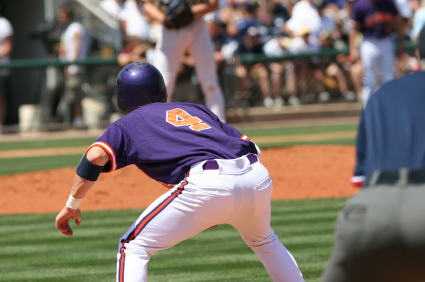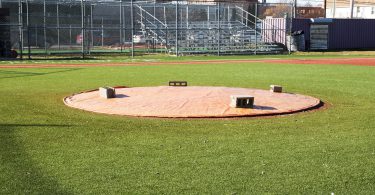By Ethan Guevin
The jump from high school to college exposes flaws even in good base runners, as arms are stronger, defenders are faster, and decisions need to be made much quicker. We have heard from multiple coaches that base running ability can be the difference between getting in the game and riding the bench, especially your freshman year. Talent for speed can’t be taught, but there is no substitute for good base running. In this final segment of our series on base running, we offer tips to improve your base running during plays that put the runner in motion– specifically, stealing, hit-and-runs, and delayed steals. In all of these situations, technique and skill won’t help if you’re predictable or easy to read. Just like a pitcher can tip his pitches to a hitter, base runners sometimes throw up a red flag, letting the defense know something is up. Base runners can do this by taking their eye off of their coach as soon as they get the sign even if the coach is not finished giving signs, or taking a lead that looks different from a “normal” lead. You’ll give yourself away if you take your lead too quickly, or vary the timing of your lead for the first time, change the length of your lead, take a different stance when in your primary lead, get jumpy or antsy, or use many other “tells.”
In order to combat this, make sure you follow your normal base running process or protocol. Watch the signs from start to finish. Take your lead the way you always do it. Everything should be the same, every time. You may take your standard lead differently for every pitcher (lefty vs. righty, a guy who quick picks vs. hold and pick guys, etc.), but within your team’s system and for each pitcher, the basic lead should be the same. You can find some tips to help you come up with a standard way you take your lead in an earlier blog post.
Now, let’s look at each of the plays that put a runner in motion. As always, your situation is incredibly important. We will examine each of these plays from the runner starting at 1st base.
Stealing:
Before you even get the steal sign, you should know the situation. You need to know the quality of the pickoff moves the pitcher has, a general sense of how quick he delivers the ball to the plate, any tendencies the pitcher has, keys he gives off that he is either picking or delivering home, etc. Stealing is the riskiest of the three plays, because you have no protection from the hitter and a lot is riding on your jump. To become a better base stealer, the first few steps are critical. Remember, tension kills quickness, so start by being relaxed. While some players use a straight cross-over, this method has fallen out of favor by the world’s best base stealers. We want to show you another technique that may help you gain the edge you might need to swipe more bags. To avoid the negative connotation of the term “negative step,” we will call it a small lead foot “drop step.”
The lead foot drop step helps to get base runners in a running position or sprinters up to full speed as quickly as possible. Even though they don’t gain ground with their first step, the runners get up to full speed in their first few steps. Watch youtube examples of some of the MLB’s finest taking a small negative step with their lead foot to open their hips and get moving full speed quicker:
http://www.youtube.com/watch?v=mexY0A_009c
Here is another illustration and break down:
http://www.youtube.com/watch?v=TofLT0R5OL4
Hit and Run:
We don’t want to sound like a broken record, so for more detailed information on the hit and run, we refer you to a previous article tacking the subject.
We will recap the most important parts here:
– Like stealing, your lead needs to be the same so you don’t tip your hand.
– You should never get picked off.
– Make sure you look in to pick up the batted ball. Ask your coach whether he wants you to peak in, or watch the pitch the entire way.
– Line drives head high or lower, keep running unless you see the ball caught. Once the line drive is caught, do your best to get back.
– You are trying to steal the base if the hitter fails to put the ball in play, but the expectation is that you will advance on the batted ball and not steal the base outright. As such, pickoffs should never happen. Period.
– Stay running in line with 2nd until the play dictates that you should gain depth to allow yourself the best chance to get to 3rd.
Delay
Delays are an attempt to try to catch the defenders off-guard. Many times, coaches call a delay when the infielders or catchers are not paying close attention. It is not a rushed play, timing is everything. On delays, you want to draw as little attention to yourself as possible. Ask your coach about the timing and technique he would like you to use. Below are some general guidelines and delayed steal techniques:
-Get the same lead and don’t do anything to tip your hand.
-When you extend with your shuffles, try to make it look as similar to your normal secondary as possible.
– Jumping up really high or really far often draws attention because it is different from usual, and tips off the infielders.
– You are trying to catch the infielders/catcher off guard. This element is more important than getting to 2nd as quickly as possible. You are stealing off of hesitation and confusion, not trying to exploit the pitcher/catcher times getting the ball to 2nd.
– Timing is everything. Talk to your coach about the technique he wants and get it down pat. Going too early or too late will often result in you getting thrown out.
We hope these tips help you become a better baseball player. If there is something we didn’t cover that you would like us to address, reach out to us on twitter or Facebook and we will do our best to cover it ASAP. You can read any of the five previous articles of the mini-series by clicking on the links below.







